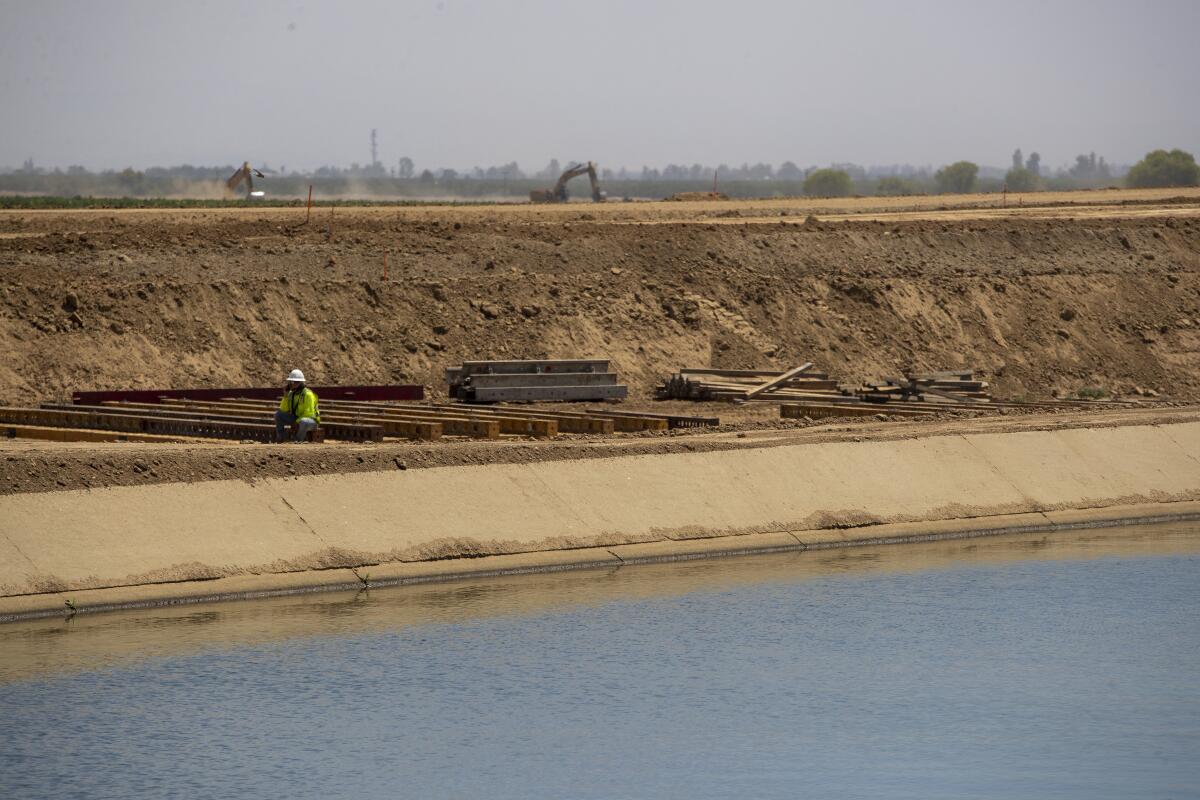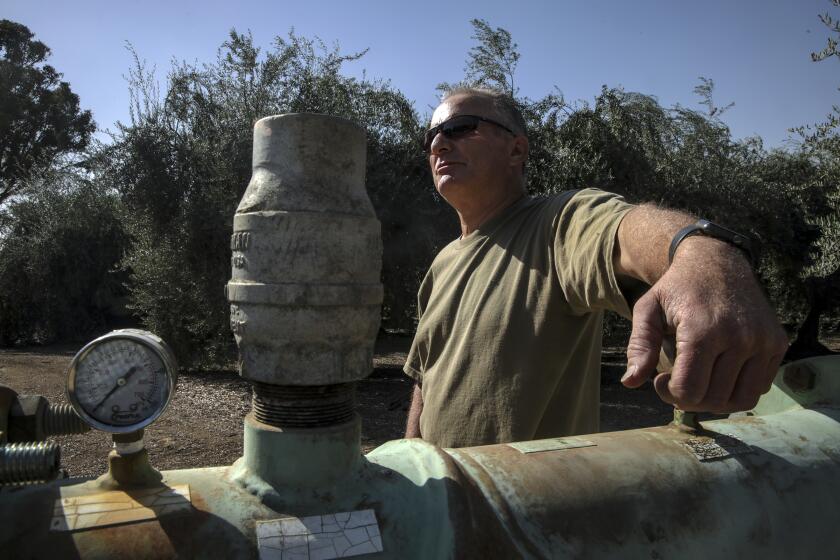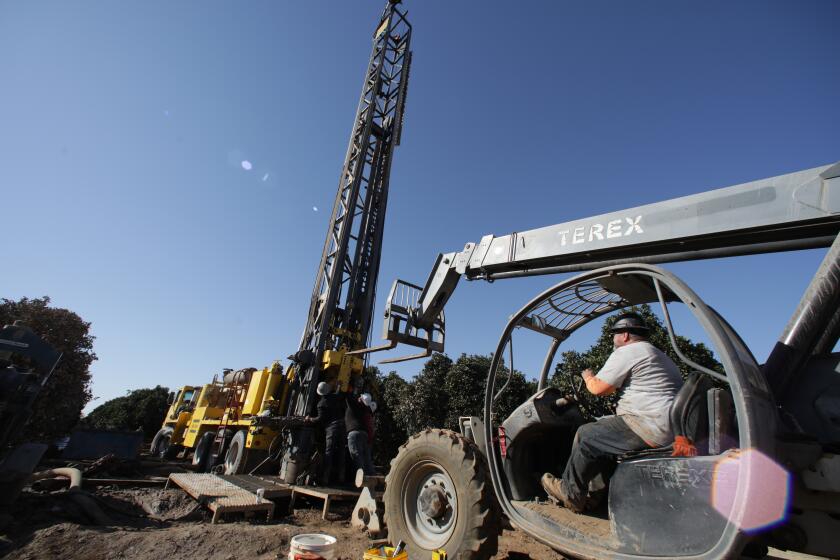California regulators reject San Joaquin Valley groundwater management plans

- Share via
California regulators have told local agencies in large portions of the San Joaquin Valley that their plans for combating overpumping of groundwater are inadequate, a step that clears the way for state intervention to curb chronic declines in water levels and prevent more wells from going dry.
The Department of Water Resources announced Thursday that officials have determined local groundwater plans are inadequate in areas of the San Joaquin Valley where heavy agricultural pumping has drawn down aquifer levels and left rural homeowners with dry taps.
The so-called groundwater sustainability plans are required under California’s 2014 Sustainable Groundwater Management Act, which aims to address widespread problems of groundwater depletion in many areas by 2040.
It’s the first time California has declared local groundwater plans insufficient under the law, which now allows state regulators to step in and require stronger regulation.
Well-drilling and pumping continue to draw down groundwater in California’s Central Valley. Calls are growing for stronger legislation and state intervention.
The State Water Resources Control Board has the authority to hold hearings and consider whether to put the groundwater basins on probation. If the board deems an area “probationary” after holding a hearing, it has the power to require well owners to install meters, start reporting how much they are pumping, and begin paying fees to cover costs.
Declaring these local plans inadequate is an important step in implementing the state’s groundwater law, said Paul Gosselin, deputy director of the Department of Water Resources’ sustainable groundwater management office.
While the law puts local agencies in charge of dealing with problems of groundwater overdraft, it calls for state intervention as a backstop. The state water board’s oversight is intended to help local agencies fix weaknesses in their plans and get on track toward curbing excessive pumping.
“Our goal is for basins to resolve issues quickly,” said Natalie Stork, a state water board official. “We want to see all of these basins be successful, and a key part of that is continuing to move forward on plan implementation and fixing the issues that have been identified.”
In declaring the local plans inadequate, state officials cited weaknesses in how managers of local groundwater agencies plan to address chronic lowering of water levels and the likelihood of more household wells running dry.
They also pointed to flaws in how the agencies intend to address ongoing consequences of groundwater depletion, including worsening drinking water quality and the problem of sinking land as the ground collapses — which has already damaged canals and reduced their water-carrying capacity in parts of the valley.
The Department of Water Resources found the local plans inadequate in six subbasins: Chowchilla, Delta-Mendota, Kaweah, Tule, Tulare Lake and Kern, which cover large portions of valley farmland and where groundwater is considered to be in “critical overdraft.”
California passed its landmark groundwater law in 2014. The goals of sustainable management remain a long way off.
The department also endorsed plans for six other areas, from Paso Robles to Merced County. State officials said those local agencies will continue to address “corrective actions” in their plans.
Among those green-lighted plans was the Westside subbasin in Fresno and Kings counties, which includes farmlands supplied by Westlands Water District. Jose Gutierrez, the district’s interim general manager, said the plan is a detailed blueprint for “ensuring a sustainable water future” for agriculture and residents.
Karla Nemeth, director of the Department of Water Resources, said local agencies have “stepped up with dedication and progress in meeting critical milestones.” She said the state is prioritizing efforts to safeguard drinking water, minimize land subsidence and protect groundwater for the future.
“Implementation of these plans, which will require difficult adjustments as we go, will ultimately provide a safe and reliable groundwater supply for communities for generations to come,” Nemeth said.
In January 2022, the department said the plans for these 12 areas were incomplete and told the local agencies to correct various deficiencies. State officials decided to accept or reject the plans after reviewing the agencies’ revisions.
Activists had recently called for state intervention in much of the San Joaquin Valley to strengthen regulation, clamp down on agricultural well-drilling and pumping, and protect drinking water supplies.
“It’s important that the state work very closely with locals to ensure that we are actually going to get put on a path toward sustainability,” said Nataly Escobedo Garcia, a policy coordinator with the environmental justice group Leadership Counsel for Justice & Accountability.
Escobedo Garcia said the state water board should act quickly to start the process of fixing inadequate plans to protect water access for residents and prevent more wells from running dry.
Groundwater levels have declined across the Central Valley during the last three years of severe drought as supplies from rivers have diminished and as agriculture has depended more heavily on water pumped from wells. Scientists have found that in recent years the pace of groundwater depletion has accelerated as agricultural pumping has drawn down aquifer levels.
More than 1,400 dry household wells were reported in 2022, the highest number since the state started tracking reports of well failures in 2013.
So far this year, 83 dry wells have been reported to the state.
Even as this year has brought record-breaking snow and rain, the decades-long toll of depleted groundwater remains in the Central Valley.
Excessive groundwater pumping has long been depleting aquifers in California’s Central Valley. Now, scientists say the depletion is accelerating.
Many of those with dry wells have been relying on water delivered by truck to household tanks while waiting for solutions.
The plans were rightly rejected by the state Department of Water Resources because, as now written, they would harm low-income people of color who rely on shallow wells, said Tien Tran, a policy advocate for Community Water Center.
“I think this means that DWR is taking drinking water really seriously, and really thinking about how we can prioritize the human right to water,” Tran said.
She and other environmental justice advocates also said they are disappointed that some plans were approved even though they have flaws in how they propose to safeguard drinking water and address the effects of climate change.
Escobedo Garcia said she hopes state officials will require meters on wells to measure pumping and “get the best picture possible of who is doing the majority of the overpumping.” She said they should also start charging pumping fees.
“It’s really, really important that we take a very critical look at what we’re doing today to ensure that we actually will have a sustainable future,” Escobedo Garcia said. “It’s about the long-term health of the entire San Joaquin Valley.”
If the state water board puts a groundwater basin on probationary status, and if the deficiencies in the area’s plan aren’t addressed within a year, the board then could force stronger measures by adopting an interim plan to manage groundwater use.
Martha Curiel, a local water activist and former farmworker in Tulare County, said she agrees with the decision not to approve the local plan.
“Many people who have private wells are being left without water,” Curiel said. “Water is life.”
Nitrate-contaminated drinking water is also a problem in the area, and Curiel said the local plan should address these issues.
Gosselin said local agencies that are now under state intervention are still expected to continue implementing their plans while they take steps to bring their plans into compliance.
The agencies in charge of each critically overdrafted basin have received about $7.6 million over the last year to help implement their plans, Gosselin said.
“A lot of them are doing incredible work that we want to see continue,” he said.










